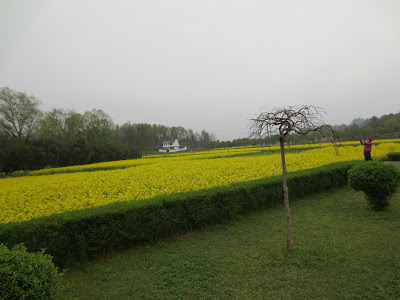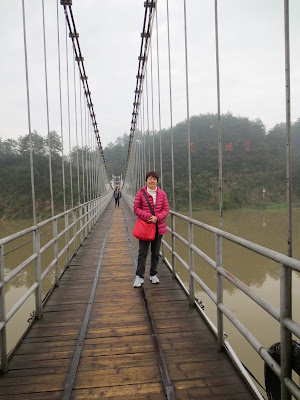11th Visit to China
2nd Visit to Shanghai
Shanghai (上海)
Shanghai (上海) is the commercial and financial hub of China.
Located in the Yangtze River River Delta in East China, Shanghai sits at the mouth of the Yangtze River, in the middle portion of the Chinese coast.
Home to more than 23 million people, Shanghai is the largest and most developed metropolis in mainland China.
Huangpu River (黄浦江)
Puxi is the historical centre of Shanghai. In the 19th century, a French Concession and an International Settlement were established in the area. The walled city remained under Chinese control.
City God Temple (城隍庙) shopping area
Although Shanghai had its own walled Chinese city, many native residents still chose to live in the foreign settlements. Thus, it began a mixing of cultures that shaped Shanghai's openness to Western influence.
It is in this area that the renowned waterfront, the Bund (外滩) and the famous Art Deco architecture are found.
AIA, the Bund
By the early 20th century, the Bund was known as the "Wall Street of Asia". Giants born there included The Hongkong and Shanghai Banking Corporation (HSBC) and Insurers American International Group (AIG).
There are still dozens of old but well-preserved, Western-styled buildings stand on the Bund.
Pudong
Pudong is home to Lujiazui (陆家嘴) financial district. The area was opened up in 1993.
the Bund at Puxi
(L): Shanghai Pudong Development Bank (上海浦东发展银行) , former Hongkong and Shanghai Banking Corporation (汇丰银行) (R): Shanghai Custom House (上海海关)
Shanghai is a city of contrast. There is an obvious difference between the two sides of Huangpu River. On the west bank (picture above), there are many well-preserved, Western-styled buildings; while the east bank (picture below) has a huge contrast in different architectural styles that many modern skyscrapers are built.
Pudong skyline
Taking a stroll along the Pudong Riverside Prominade (浦东滨江大道), visitors would experience the dramatic evolution of the city after 1990 and catch a glimpse of Shanghai's past across the river.
Pudong Riverside Prominade
Unlike many cities in China with long and varied histories, Shanghai's history is quite short.
Once a fishing village on the banks of the Huangpu River, Shanghai grew importance in the 19th century due to its deep-water port and favourable geographical location.
1842:
Then in 1842 by the Treaty of Nanjing (南京条约), the British forced China to open five ports, including Shanghai to Western trade and ceded Hong Kong Island to Britain after China had lost the First Opium War.
The British were granted the privilege of living and trading in the treaty ports.
The French and Americans soon followed the British in establishing concessions in Shanghai. Concessions were governed by the occupying countries. Eventually, the British and American concessions formally united to form the Shanghai International Settlement. The French concession remained unchanged.
It has often been said that the presence of Western powers in Shanghai had ignited the city's evolution.
St. Ignatius Cathedral, Xujiahui
徐家汇天主教堂
Ideas were also imported. Meanwhile, Western missionaries preached Christianity in Shanghai. St Ignatius Cathedral--- the first Catholic cathedral in Shanghai, was built between 1905 and 1910.
1930s:
Shanghai was already a commercial and financial centre in China before WWII.
At first tea, silk and porcelain were exported from Shanghai while opium was imported. Later, the city flourished as a centre of commerce between the east and the west. Soon, it became the most prosperous city in the Far East in 1930s.
World largest trading and banking set up houses along the Bund.
Yong An Departmental Store, East Nanjing Road
南京东路永安百货公司
南京东路永安百货公司
永安百货公司创建于1918年,它是当时上海首屈一指的高档百货公司。
Shanghai in the heyday of the 1930s was perhaps one of the most exotic, controversial and colourful cities in the world.
Shanghai in 1930
The International Settlement and French Concession were famous for their vibrant nightlife. Known as Paris of the East, Shanghai boasted fine restaurants, hotel ballrooms, dance-halls, night clubs and other Art Deco architecture.
It also had casino, greyhound and horse racing tracks.
Opium dens were prevalent in the city at that time. One of the most notorious figures in the city was Du Yuesheng (杜月笙). Du was the head of Qingbang triad (青帮), which controlled opium dens, gambling, prostitution and other criminal activities in Shanghai. Du is said to have connection with Chiang Kai-shek (蒋介石).
Between WWI and WWII:
As Shanghai at the time was an open city, no visas were required for entering Shanghai. The city soon became a haven for thousands of displaced people: White Russians fleeing Bolshevik Revolution of 1917 and European Jews escaping Nazi persecution during the Holocaust (1933-1941).
A refuge camp for the Jews known as Hongkou (虹口) Ghetto was established in Shanghai in 1943. The city literally saved thousands of Jews from death.
1937:
However, in 1937, Japan invaded China. Shanghai and much of the China's eastern coast were occupied by the Japanese until their defeat at the hands of the Allied Powers in 1945.
1943:
After the Japanese taking over of Shanghai, there was a mass evacuation of Westerners from Shanghai. The foreign concession era officially ended in 1943, bringing Shanghai's 101 years as a treaty port to a close.
1949:
Following the communist came into power in 1949, Shanghai's economy suffered until 1976 under the Cultural Revolution (1966-1976).
1990s:
The Chinese government launched a series of new strategies to attract foreign investments. The biggest move was to open up Pudong in Shanghai.
Pudong is home to many financial institutions housed in numerous skyscrapers.
Puxi
Nanjing Road Pedestrian Street (南京路步行街)
南京路在19世纪有 ‘中华商业第一街’ 的美称。
City God Temple (城隍庙) shopping area
Qipu Road (七浦路 )
Shopping at Qipu Road
Xujiahui (徐家汇)
Xujiahui was part of the former French concession. Now it is a premier commercial and living area in Shanghai.
St. Ignatius Cathedral, Xujiahui
徐家汇天主教堂
Located in Xujiahui, St. Ignatius Cathedral is a Roman Catholic cathedral. The cathedral was built by French Jesuits between 1905 and 1910. The structure has the French Gothic style. It is said the cathedral has once been known as "the grandest church in the Far East".
taking a stroll in the neighbourhood
of Xujiahui (徐家汇)
enjoying cream puff at Metro City Mall
美罗城的奶油泡芙好香呀!
Pudong
exploring Shanghai by metro 浦东正大广场
Pudong is home to Lujiazui financial district. The area was mainly farmland, neglected for centuries, until the Chinese government launched its development and opening it up to the rest of the world in 1993.
The move was a strategy to revive Shanghai as an international trade and financial centre.
Since then, Shanghai has developed at an increasing pace. It has attracted talent and capital from many countries.
Today, Shanghai is striving to be a global city.
(C): Jin Mao Tower (金茂大厦) and
(R): Shanghai Tower (上海中心大厦) in Lujiazui area of Pudong.
Shanghai Tower is currently the tallest building in China and the second tallest in the world.
night view of Pudong skyline in 2014
The free standing structure is Oriental Pearl Television Tower (东方明珠电视塔)---a symbol of "new" Shanghai.








































































































